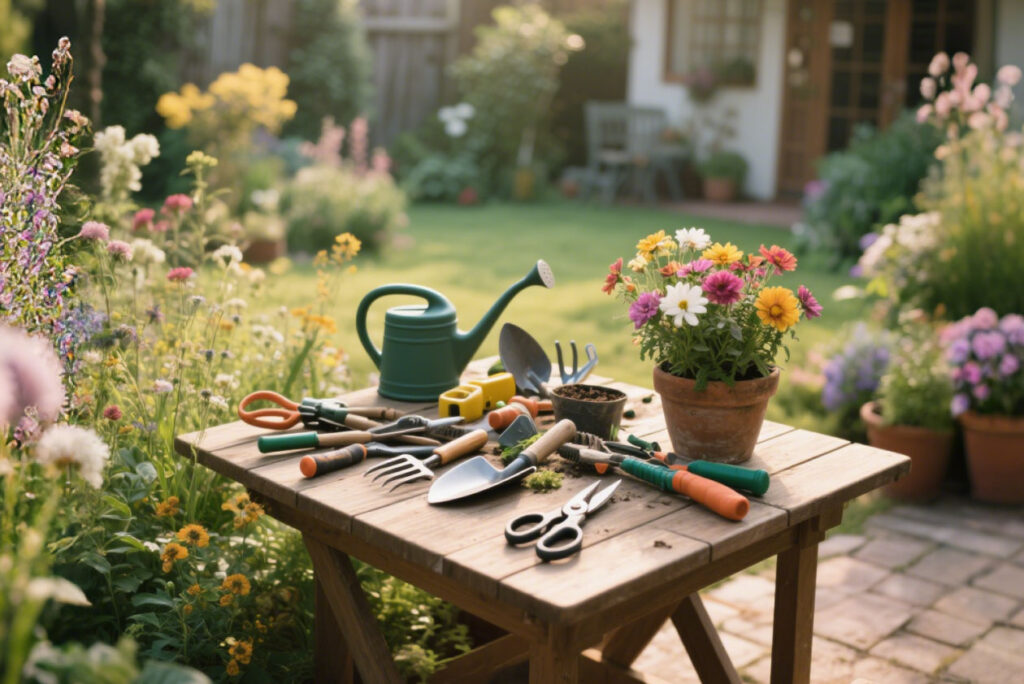Gardening Tool Cleaning and Maintenance: Rust Prevention, Sharpening, and Disinfection to Extend Lifespan by 10 Years
In the world of gardening, having a set of reliable tools is crucial. However, many gardening enthusiasts often face a dilemma: how to keep these tools in good condition and extend their service life? Today, let’s delve into the cleaning and maintenance techniques for gardening tools. From rust prevention and sharpening to disinfection, we will comprehensively care for your gardening tools, allowing them to accompany you for a decade as you enjoy the pleasures of gardening.
Ⅰ. Rust Prevention for Gardening Tools: Protecting Your Tools from Corrosion
(A) Understanding the Causes of Rust on Gardening Tools
During use, gardening tools inevitably come into contact with soil, moisture, and various organic matter. The combined action of water in the soil and oxygen in the air can easily cause oxidation reactions on the metal surfaces of tools, leading to rust. Especially in humid environments or when tools are not cleaned and dried promptly after use, rusting accelerates.
(B) Revealing Rust Prevention Methods
- Clean Tool Surfaces Promptly:
After each use, immediately remove soil, plant debris, and other impurities from tool surfaces. Use a soft-bristled brush to gently scrub away attachments, then rinse with clean water. For hard-to-clean areas, appropriate detergents may be used—avoid strongly acidic or alkaline cleaners to prevent surface damage.
- Keep Tools Dry:
Thoroughly air-dry cleaned tools to ensure no moisture remains. Place them in a well-ventilated area or wipe dry with a clean cloth. When storing tools, choose a dry environment to avoid prolonged exposure to humid air.
- Apply Rust-Preventive Oil or Wax:
After tools are dry, apply a thin layer of rust-preventive oil or wax to metal surfaces. This protective film isolates air and moisture, effectively preventing rust. Ensure even coverage without missing any corrosion-prone areas.
Ⅱ. Sharpening Gardening Tools: Restoring Tools to Razor-Sharp Condition
(A) The Importance of Sharpening
Sharp gardening tools not only improve efficiency but also minimize plant damage. When pruning, sharp tools enable precise cuts, preventing plant tearing caused by dull blades—promoting healthier plant growth.
(B) Basic Principles and Methods of Sharpening
- Select Suitable Sharpening Tools:
Common options include sharpening stones, oil stones, and sandpaper. Sharpening stones suit major edge repairs; oil stones provide fine polishing; sandpaper handles localized grinding for hard-to-reach areas. Choose based on tool material and blade wear.
- Maintain Correct Sharpening Angles:
While blade shapes vary, most gardening tools require angles between 20°–30°. Keep the angle consistent during sharpening—avoid fluctuations that compromise results. Angle guides or clamps ensure accuracy.
- Adopt Proper Sharpening Technique:
Use a “push-pull” motion: Starting from one end of the blade, move the sharpening tool along the edge at a fixed angle. Repeat until sharpness is restored. Monitor blade condition and adjust pressure/angle as needed.
III. Disinfecting Gardening Tools: Preventing Disease Transmission
(A) Why Disinfection is Necessary
Tools contact various plants and soils, potentially carrying pathogens, viruses, and pests. Without disinfection, these harmful organisms can spread to healthy plants, causing disease outbreaks that threaten the entire garden.
(B) Effective Disinfection Methods
- Chemical Disinfection:
Soak tools in disinfectants like alcohol, peracetic acid, or potassium permanganate for 15–30 minutes. Rinse and air-dry. Note: Follow concentration guidelines and safety precautions to avoid harm to humans/plants.
- Physical Disinfection:
Methods include high-temperature steam or boiling. Expose tools to steam or submerge in boiling water for 10–15 minutes to kill pathogens. Caution: Unsuitable for heat-sensitive materials.
Ⅳ. Comprehensive Cleaning and Maintenance Procedure
Follow this integrated workflow to ensure optimal tool condition:
- After each use: Immediately remove soil/debris; rinse with water.
- Inspect for damage/wear; repair or replace parts.
- Sharpen blades to maintain cutting performance.
- Disinfect using appropriate methods to eliminate pathogens/pests.
- Apply rust-preventive oil/wax.
- Store in a dry, ventilated location.

Through these meticulous care practices, your gardening tools will become more durable and efficient, accompanying you for years while creating stunning gardens. Remember: Regular maintenance is key to extending tool lifespan and ensuring gardening quality. Start prioritizing tool care today to fully embrace gardening’s endless joys!
